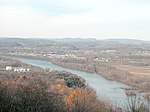Shikellamy State Park
1960 establishments in PennsylvaniaIUCN Category IIIParks in Northumberland County, PennsylvaniaParks in Union County, PennsylvaniaProtected areas established in 1960 ... and 2 more
State parks of PennsylvaniaUse mdy dates from August 2023

Shikellamy State Park is a 132-acre (53 ha) Pennsylvania state park located at the confluence of the West Branch Susquehanna River and Susquehanna River in Pennsylvania. The park is divided into two sections. The older part, on a bluff on the western bank of the Susquehanna River, is the 78-acre (32 ha) Shikellamy overlook in Union Township, Union County. The newer part is the 54-acre (22 ha) marina on the southern end of Packer Island in Upper Augusta Township, Northumberland County. Packer's Island lies between the city of Sunbury and the borough of Northumberland at the confluence of the two branches of the river.
Excerpt from the Wikipedia article Shikellamy State Park (License: CC BY-SA 3.0, Authors, Images).Shikellamy State Park
East Drive, Upper Augusta Township
Geographical coordinates (GPS) Address Website External links Nearby Places Show on map
Geographical coordinates (GPS)
| Latitude | Longitude |
|---|---|
| N 40.880555555556 ° | E -76.804722222222 ° |
Address
Shikellamy State Park
East Drive
17801 Upper Augusta Township
Pennsylvania, United States
Open on Google Maps








